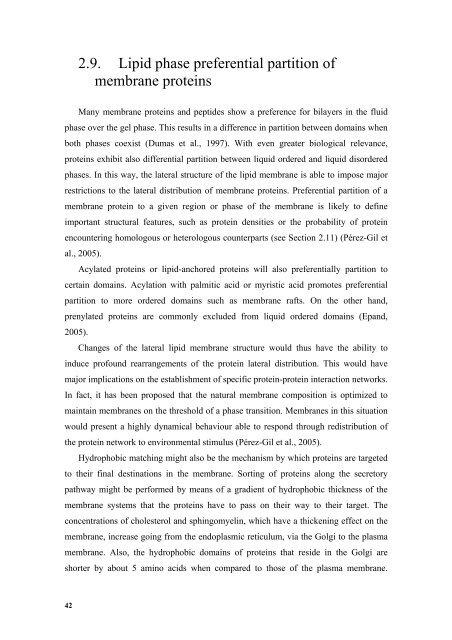Biophysical studies of membrane proteins/peptides. Interaction with ...
Biophysical studies of membrane proteins/peptides. Interaction with ...
Biophysical studies of membrane proteins/peptides. Interaction with ...
Create successful ePaper yourself
Turn your PDF publications into a flip-book with our unique Google optimized e-Paper software.
2.9. Lipid phase preferential partition <strong>of</strong><br />
<strong>membrane</strong> <strong>proteins</strong><br />
Many <strong>membrane</strong> <strong>proteins</strong> and <strong>peptides</strong> show a preference for bilayers in the fluid<br />
phase over the gel phase. This results in a difference in partition between domains when<br />
both phases coexist (Dumas et al., 1997). With even greater biological relevance,<br />
<strong>proteins</strong> exhibit also differential partition between liquid ordered and liquid disordered<br />
phases. In this way, the lateral structure <strong>of</strong> the lipid <strong>membrane</strong> is able to impose major<br />
restrictions to the lateral distribution <strong>of</strong> <strong>membrane</strong> <strong>proteins</strong>. Preferential partition <strong>of</strong> a<br />
<strong>membrane</strong> protein to a given region or phase <strong>of</strong> the <strong>membrane</strong> is likely to define<br />
important structural features, such as protein densities or the probability <strong>of</strong> protein<br />
encountering homologous or heterologous counterparts (see Section 2.11) (Pérez-Gil et<br />
al., 2005).<br />
Acylated <strong>proteins</strong> or lipid-anchored <strong>proteins</strong> will also preferentially partition to<br />
certain domains. Acylation <strong>with</strong> palmitic acid or myristic acid promotes preferential<br />
partition to more ordered domains such as <strong>membrane</strong> rafts. On the other hand,<br />
prenylated <strong>proteins</strong> are commonly excluded from liquid ordered domains (Epand,<br />
2005).<br />
Changes <strong>of</strong> the lateral lipid <strong>membrane</strong> structure would thus have the ability to<br />
induce pr<strong>of</strong>ound rearrangements <strong>of</strong> the protein lateral distribution. This would have<br />
major implications on the establishment <strong>of</strong> specific protein-protein interaction networks.<br />
In fact, it has been proposed that the natural <strong>membrane</strong> composition is optimized to<br />
maintain <strong>membrane</strong>s on the threshold <strong>of</strong> a phase transition. Membranes in this situation<br />
would present a highly dynamical behaviour able to respond through redistribution <strong>of</strong><br />
the protein network to environmental stimulus (Pérez-Gil et al., 2005).<br />
Hydrophobic matching might also be the mechanism by which <strong>proteins</strong> are targeted<br />
to their final destinations in the <strong>membrane</strong>. Sorting <strong>of</strong> <strong>proteins</strong> along the secretory<br />
pathway might be performed by means <strong>of</strong> a gradient <strong>of</strong> hydrophobic thickness <strong>of</strong> the<br />
<strong>membrane</strong> systems that the <strong>proteins</strong> have to pass on their way to their target. The<br />
concentrations <strong>of</strong> cholesterol and sphingomyelin, which have a thickening effect on the<br />
<strong>membrane</strong>, increase going from the endoplasmic reticulum, via the Golgi to the plasma<br />
<strong>membrane</strong>. Also, the hydrophobic domains <strong>of</strong> <strong>proteins</strong> that reside in the Golgi are<br />
shorter by about 5 amino acids when compared to those <strong>of</strong> the plasma <strong>membrane</strong>.<br />
42















